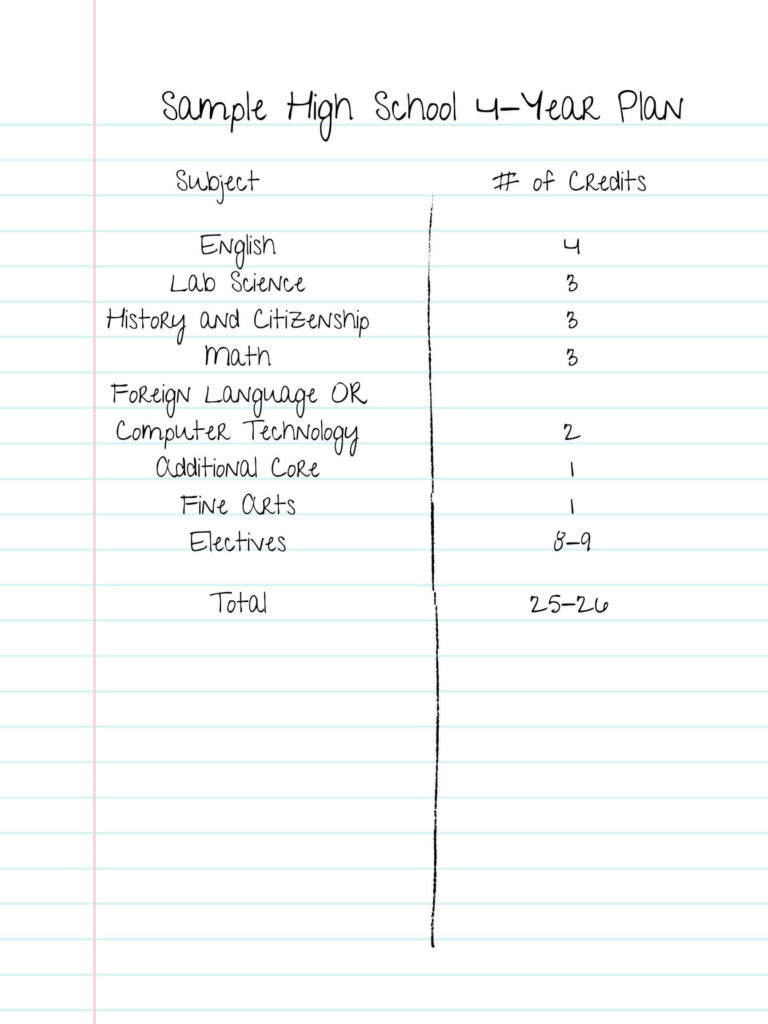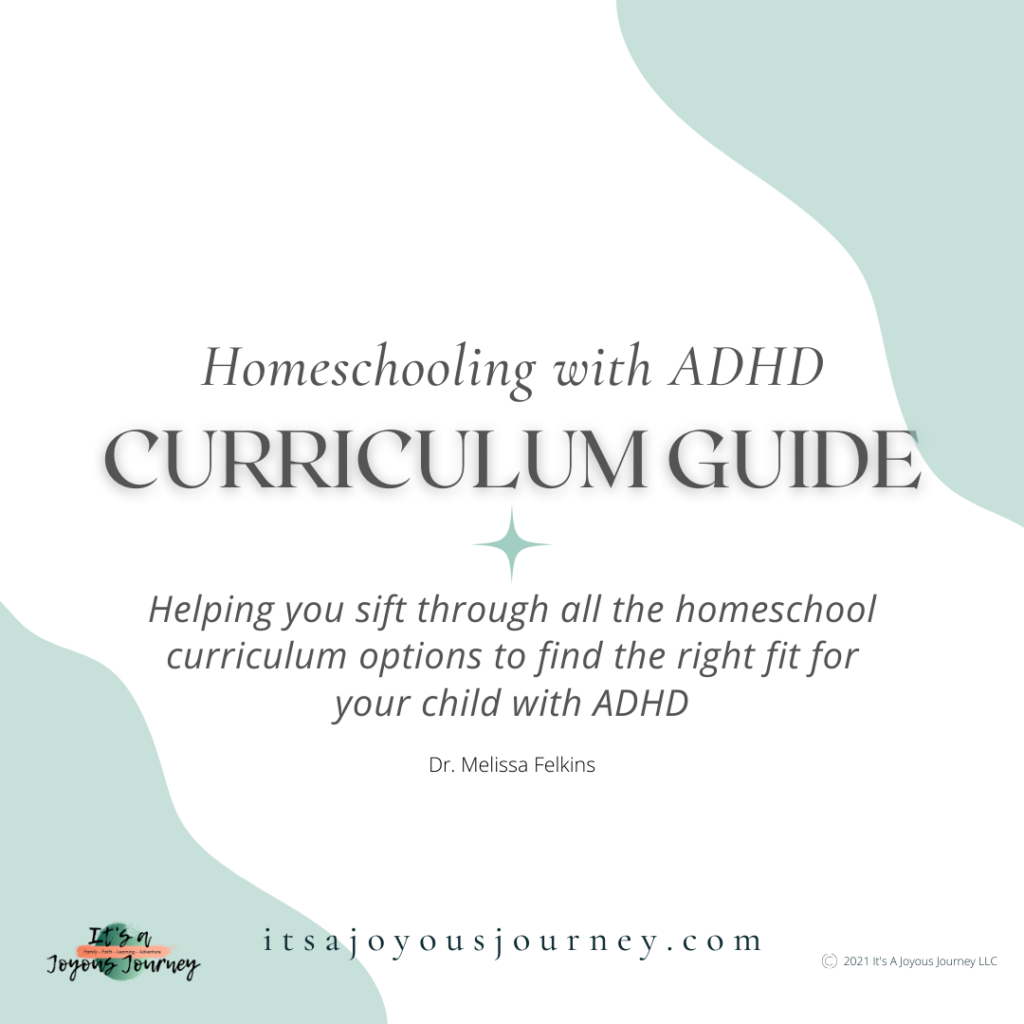When you homeschool high school, curriculum planning can be one of the biggest challenges. Let’s break it down into some manageable steps, so you can be confident in your choices!
This page may contain affiliate links from which we may earn a commission, at no additional cost to you, when you click and/or make a purchase from our partners. Sometimes, we also include links to external sites, from which we do not earn a commission. We have simply provided these links as a convenience to our readers. We make no claims and hold no responsibility for the content of the linked sites. See our Disclosure Policy for more information.
“How do I know which homeschool curriculum to choose?”
“Should I use an all-in-one program or piece it together?”
“Do I need an accredited program?”
“There’s so much to choose from! It’s so overwhelming!”

I have been seeing these questions and statements over and over again the past couple of months. Understandably, a lot of people who have never considered homeschooling before have now decided to give it a try due to the uncertainties surrounding traditional schooling during a pandemic.
Whether you are in that boat or you are a veteran homeschool mom who just needs some direction on how to start planning to homeschool high school, I hope this will make the curriculum planning process a little less daunting.
A note about traditional homeschooling vs. online charter schools…

Just as a note to clarify, the steps I will be discussing here apply to traditional homeschooling, not online charter schools. If you’re wondering why I’m specifying that, it’s because the two fall under different sets of laws. Although the home is the main setting for both, online charter schools are subject to state attendance and testing policies mandated to public schools. While some charter schools do offer a limited number of choices regarding curricula, most follow a set curriculum for all students.
I’m not here to tell you what choice you should make for your own family. I think that is a very personal decision that should be based on a number of factors. I just want you to know that the information given here only applies to traditional homeschooling.
My only comment on this is that I urge you to do whatever will give each of your children the best opportunity for success. I even know families who do online charter school for some of their children and traditional homeschooling for others.
If you’re planning to go back to public school after the pandemic, an online charter school may make that transition a little easier, as they may not require as much placement testing upon return. But if you’re ready to jump into traditional homeschooling for high school with both feet, keep reading!
Step 1: Know your state’s homeschool laws

It is legal to homeschool in all 50 U.S. states. Every state has different laws for homeschooling, though, and it’s your responsibility to find out what those are for your state and make sure you follow them. Here’s a good place to start. If you’re not in the U.S., please seek out your country’s own laws regarding homeschooling. I believe the U.K. is quite homeschool-friendly, but I don’t know about most other countries.
While some states do not require any reporting, others have strict provisions and may even stipulate that you operate under an umbrella school. Once you know what your state requires, that may give you a framework to work within. For example, some states will mandate how many credits of each subject your student will need to complete at the high school level. If not, don’t worry! There are plenty of other resources to help you out. Personally, I’d rather have both the freedom and the responsibility of my kids’ education, so I’m happy to live in a state with no regulations.
Step 2: Read up on some different homeschooling philosophies and practices
There are quite a few different approaches that homeschooling families take towards educating at home and knowing which one you most closely align with can help point you in the right direction when choosing curricula. Some of the methods seem to lend themselves more to teaching younger children, so you’ll want to make sure to choose one that is practical for your family’s needs as you begin to homeschool high school.
A good overview of the different philosophies can be found here. And you can take a quiz that might help you see which ones you most align with here. I don’t know how scientifically accurate the quiz is (the educational psychologist in me always wants to make sure these types of instruments have been verified as reliable), but I took it myself and it seemed to reflect my appreciation of eclectic learning. Although not surprising to me at all, I do think it’s funny that I am a former public school teacher and counselor, and I scored lowest (-17, in fact) on traditional education!

Step 3: Talk to your kids about what and how they want to learn
Once your kids reach middle and high school, it’s really essential for them to have some input about what they learn and how they learn it. If they take ownership of their learning, it will be more meaningful to them and less stressful for everyone involved. Of course, there will always be things that are not a kid’s favorite that they have to work through. But even with those things, if you can get your student involved in choosing the way in which they will learn, it can make a world of difference.
In our house, algebra has been a struggle for everyone. We have tried so many different programs. My oldest two have managed to get through both Algebra 1 and 2 with A’s, but my youngest (who will be a freshman this year) was just really dreading high school math. We worked together this summer to find a program for her to use that she is actually excited about, and I can’t wait to see how she does with it!
Don’t forget to talk to your kids about whether they prefer to learn from textbooks, online programs, videos, etc. Discuss whether they might want to attend a homeschool co-op and what extra-curricular activities are most important to them. Of course, you have the final say in this, but trying to force your kids to learn in a way that they don’t enjoy…well, let’s just say that you’re not going to enjoy it very much either!

Step 4: Write down your 4-year plan
I like to start with a 4-year plan to homeschool high school and work backwards from there to choose courses for each school year. If your state requires a certain number of credits for each subject, you can use that. If not, there are several other options. You might want to read my Homeschool Graduation Requirements Guide to help out with this.
I use a combination of sources to put together the 4-year plan. First, my kids have been accepted to a state scholarship program that has credit requirements, so I make sure those are covered. Then, I look at local high school graduation plans and admission requirements for any colleges my kids might be interested in attending to see if there is anything from those that could enhance our plan. Next, I talk to my kids about what courses they may want to take and whether they might want to do concurrent classes or vo-tech programs that are offered in our community. Finally, I add in their extra-curricular activities that can be counted as credits.

*Check your own state’s requirements
Step 5: Break it down by school year
Once I have the overall plan written down, I start breaking it down by which courses they will take each year. Remember, if you’re planning to homeschool through graduation, there’s no need to take all courses in the same sequence that the public school offers them.
Of course, there are some that are prerequisites for others, but for most courses, the order in which your student takes them doesn’t matter. For instance, you might choose to do US history and government back to back, rather than doing US history in the 10th grade and government in the 12th. We have switched things up quite a bit over the years, so that my kids who are a couple of years apart in grade-level could take courses together, allowing for group projects, discussion, peer-reviewing, and so much more. It just makes a lot of sense!
One important point to keep in mind here-Keep some flexibility in your plan! Chances are, something will change over the course of four years, and that’s okay. If you decide you want to pull a course from junior year to sophomore year, do it. If your kid takes one semester of computer classes and decides they’d rather do two years of foreign language instead of two years of computer technology, no big deal.
As long as the end result gets you where you need to be,
don’t allow yourself to fret too much over how you get there.

*Check your own state’s requirements
Step 6: Consider factors that might affect curriculum planning
There are a few more factors you might want to consider that will affect your curriculum planning. Will you join a homeschool co-op? Are there any special learning needs that need to be considered? What extra-curricular activities will your students participate in? Are concurrent courses or vo-tech programs going to be a part of your student’s high school experience? And, finally, how can you maximize your budget to meet your family’s homeschooling needs?
Homeschool Co-ops
If you go with a homeschool co-op, the teachers there will choose the curriculum for each class, but you’ll usually need to purchase books and supplies in addition to paying co-op fees. Your student may or may not take all of their courses through the co-op. If they don’t, you can fill in for any at-home classes with your own curricular choices.
We’ve done co-ops in a few different ways. When the kids were younger, we did a co-op with some friends that was mostly for social interaction and to give the kids some opportunities to do things like science experiments, craft projects, Valentine’s and Christmas parties, PE, field trips, and presentations in front of a group of people. It was a lot of fun and served us well in elementary school/early middle school.
When my oldest got to upper middle school, I felt like we needed something with more structure, so we joined a homeschool co-op that was more academically-focused. The first year, we jumped in with both feet and took all of our classes through the co-op. That meant we’d go to co-op one day a week, then we’d spend the rest of the week completing the assignments that were to be turned in the following week in class. That was way too much for us. We ended up having to drop a class or two, because we just couldn’t keep up.

The next year, we did a few core classes, a few electives, and a few classes that were just for fun and didn’t have any homework (PE, cooking, etc.). This worked out pretty well for the most part, but one of my kids was still struggling with the pacing of the core classes. When this child came to me with tear-filled eyes and said, “Mom, I thought we started homeschooling so I could go at my own pace,” I knew something had to change.
You see, individualized learning is the cornerstone of my personal educational philosophy. It was my motivation for pursuing my Ph.D. My goal was to be a voice to promote individualized learning for all students. But, I had failed to provide that for my own child, who I knew had learning challenges. #momfail
When the second semester rolled around, that child didn’t go back to co-op with the rest of us. Instead, he would take his computer with him and go to work with my husband every Tuesday at the church. He’d do a little work on the online program we had enrolled him in, and he’d do a lot of guitar playing and drumming. It worked out great for him and now he’s the best lead guitar player and one of the best drummers I know!
One child needed something different from the others,
and that was okay.
We continued in the co-op with the other two kids for a couple more years, making sure we kept a manageable balance of home and co-op courses. It was a wonderful experience of homeschool community, and I’m truly thankful for the time we had there. Unfortunately, I had some major health issues arise that made it difficult for us to continue in that setting. After much discussion with the kids and making sure they were okay with it, we decided it was time for us to leave the co-op.
Special Learning Challenges
If you have a child with special learning challenges, such as ADHD, dyslexia, dyscalculia, dysgraphia, or others, you’ll really want to keep that in mind as you do your curriculum planning. There are choices that seem to work better for most kids with certain challenges. Keep in mind, though, that even among those who may have the same label to their learning challenges, individual experiences can vary greatly.
Talk to your kids about what works best for them. My article, Tips for Homeschooling with ADHD, will give you some good talking points to help you and your student come up with a good plan to meet their individual learning needs.
Extra-Curricular Activities

Extra-curricular activities are an important part of many homeschool families’ lives! Band, choir, sports, debate, 4-H, theater, fine arts programs, robotics…you name it! In our community, there are just as many options available for homeschool students as there are for public school students. I realize it’s not that way everywhere. My advice…if the activity your kid is passionate about is not available in your community, see if you can generate enough interest to get it going. It’s got to start somewhere!
These extra-curricular activities can (and should) count toward your students’ high school credits just like they do for other schools. We’ve been involved in many of these activities over the years, and, believe me, these kids put in the work and the time! There’s no reason they shouldn’t receive the credit they have earned.
The one caution I will give you about this…less is more. Between homeschool co-ops, extra-curriculars, part-time jobs, and volunteer work, it’s easy to over-commit, not have enough time to actually get school work done, and experience burn out. It might take a little time to find the right balance, but you’ll know it when you get there!
Concurrent Courses and Vo-Tech Programs
Both concurrent courses and vo-tech programs can add a lot of value to your high school student’s experience (and their transcript)! Generally, these options are utilized in the last two years of high school, but there are exceptions to that.
Concurrent courses are taken through colleges (either in-person or online) and provide dual credit for both high school and college. Vo-tech schools offer certification programs like cosmetology, welding, graphic design, culinary arts, etc. Some states cover tuition for high school students (yes, even homeschool high school students) who choose one of these options.

Budget
Oh, the budget…
Homeschooling can quickly get very expensive! All those great curricula choices, homeschool co-ops, and extra-curricular activities-you have to pay for them and they’re not cheap!
There are a few free things out there on the internet, so if you’re on a really tight budget, you might want to consider utilizing a few things like Khan Academy and Easy Peasy All-In-One Homeschool for some courses.
You can also save money by purchasing used curricula. Check out homeschool curriculum re-sell Facebook groups, Ebay, and Amazon. Make sure you check the publisher’s policy on the re-sell of their products, though. Most don’t mind and some will even provide an extended license needed for certain components (like CDs) to the new owner.
Most publishers run big sales a few times per year, as well. Don’t give up on a curriculum just because it’s expensive. Sign up for the email list of the publishers you like the most to hear about sales and coupon codes!
Swap with other homeschool friends. No reason to leave perfectly good curricula sitting on the shelf for a whole year in two different households when it could be put to good use with a swap that would be beneficial to both parties!
Save your stuff to use with younger siblings. While this doesn’t always work out the way we had envisioned due to individualized learning needs, if you really like a curriculum and think you will use it again, save money next time by shopping on your own bookshelves!
Utilize your local library. Libraries are a homeschool family’s best friend! Not only are they great for checking out books, many have a great variety of online resources. We’ve used our library’s website to check out audiobooks, access research databases, and even take free foreign language courses!
Step 7: Start looking at curricular options
So, now you know your state’s homeschooling laws. You’ve got an idea about which homeschooling philosophy you align with and what type of learning your kids prefer. You’ve put your plan on paper, and you’ve considered all of the other factors that might affect your choices of homeschool curricula.
You mean we’re at Step 7 and we’re just now looking at actual curricula? I know…it’s a lot! But if you take the time to work through these steps, it should be a little less overwhelming to start sifting through your curricular options.
Cathy Duffy’s reviews are a great place to start! She really seems to give objective reviews without personal bias, and I have never come across a curriculum for which I couldn’t find a review on her site. You can filter and sort your search in just about any way you’d need to in order to find things that are tailored to your needs, as well.
If your child happens to have ADHD, make sure you download my Homeschooling with ADHD Curriculum Guide that offers a great comparison of the benefits and features as they pertain to students with ADHD.
Step 8: Narrow it down
Once you have a few things in mind, start digging a little deeper.
Try before you buy! Make sure you look at samples of anything you’re interested in trying. Any good curriculum will offer PDF samples, video samples, and/or free trials to help you decide if it is a good fit for you.
If you’re still not sure, see what other people think. Read or watch blogger reviews. Ask questions or search for info in Facebook groups. Be careful with this part. It can get super overwhelming, since you will hear so many different (often strong) opinions, but it can be useful to solidify or veto an option. Just make sure you remember that different things work for different people.
Don’t allow yourself to fall victim to the homeschool mom comparison game.
You know your kids best!
Step 9: Make your final decisions
Guess what? You will not find a perfect curriculum!
Go with your gut and take the plunge. Remember…you are not a slave to the curriculum! If you need to modify something to make it fit your learner’s needs, that’s okay. You are not going to mess up your kid’s future. How do I know that? If you’ve taken all the steps to get to this far, you’re going to do what it takes to ensure the best possible outcome.

Step 10: Use a homeschool planner to set up your school year
This last step can make a world of difference in your day-to-day homeschool! I think every homeschool family should use Homeschool Planet.
It’s an online planner that allows you to set up lesson plans by subject, student, and date but allows you the flexibility to move things around easily, if needed. Each student has their own login, where they can see what they have assigned for the day and mark it off as they complete it.
Homeschool Planet even has lesson plans for many of the popular publishers that you can purchase and upload directly into the planner. Talk about a game-changer!
Plus, they offer a 30 free trial! Go try it out and see for yourself. I can’t say enough good things about Homeschool Planet. Read more about why we love it here!

You’ve got this, homeschool mama!

I know there is a lot to this, but breaking it down step-by-step and tackling one chunk at a time should help the process go a little more smoothly.
And you know what? If you don’t have everything completely ready by the first day of school, it’s not the end of the world!
Especially if you fall within the group of people who weren’t planning to homeschool before the pandemic, cut yourself some slack. It’s okay to start the year off with what you’ve got and add more things in as you go. It will probably be less stressful on everyone to ease into a full load anyway.
Remember, you’re not bound by the traditional school schedule anymore.
Do what works for your family!
My prayer is that you will walk through this curriculum planning process in peace and confidence knowing that your love for your children and your diligence in making the best choices for them will help them grow to be kind and generous contributors to our world.






Cindy
Great info! I homeschooled all three of my kids through high school. When they were younger we did unit studies. In 7th/8th grade we began switching to more traditional learning to prepare for high school and college. By high school they had the fundamentals completed. We focused on math and writing and began prep toward college entrance tests. They also began pursuing their chosen interests and career paths. We were part of a wonderful co-op that offered extra curricular activities such as art, PE, basketball, choir, etc. once day a week. No regrets at all from any of us that we chose homeschooling over public education.
Melissa F
That’s so great, Cindy! We have truly cherished our homeschool years, too!
Kendra
This is so interesting. I had no idea that homeschooling and online schooling followed such different rules.
Melissa F
Yes, many who are new to home education get caught off guard, I’m afraid, because traditional homeschoolers will often be very quick to inform those who are choosing public charter schools that they are not really homeschooling, by definition. These folks mean well, as they are trying to preserve the homeschooling freedoms in our nation and make sure the lines don’t get blurred between public school at home and traditional homeschooling. I think it’s often addressed in a manner that causes division, rather than support, though. My goal is to support families in making the decisions that are best for their own situations by providing information I’ve learned through research and experience.
Danielle Ardizzone
Timely post. I keep seeing more and more of my friends and acquaintances opting for homeschool, given the current situation.
Melissa F
Families are facing such difficult decisions these days (as are schools)! Such a crazy time we’re living in!
leeandra
Great tips for approaching homeschooling!
Melissa F
Thanks!
Santana
What a great post, and lots of helpful tips! I’m a ways off from homeschooling (we have a 6 month old), but this has given me a lot of food for thought!
Melissa F
Thank you!
Amy
I’m definitely going to share this with some of my friends with high schoolers because they are in panic mode over how they are going to do this. I only have to deal with kindergarten thank goodness so it won’t be too bad.
Melissa F
Thank you for sharing! I hope it helps your friends!